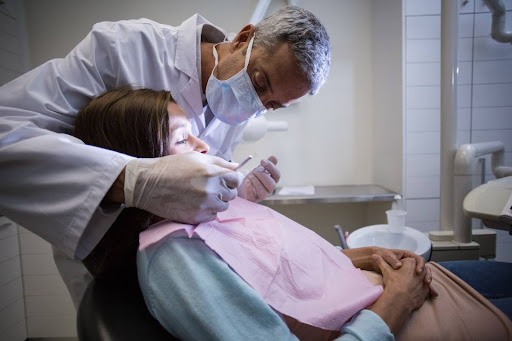
The Role of Dental Exams in Preventing Gum Disease
A healthy smile is more than white teeth; itís also about strong, disease-free gums. Many people notice mild bleeding or swelling but dismiss it as harmless. Over time, these subtle symptoms can progress into gum disease, causing tooth loss and discomfort. Dental exams provide a crucial window for spotting these problems before they escalate. Maintaining this habit builds a foundation for oral health that lasts a lifetime.
Why Dental Exams Matter for Gum Health
Dental exams are the most reliable way to detect gum problems before they progress. Many gum conditions start with subtle symptoms such as mild bleeding or swelling. These early signs can worsen without professional evaluation and care. Regular dental visits allow patients to address concerns promptly and preserve long-term oral health.
Understanding Gum Disease
Gum disease develops in two stages: gingivitis and periodontitis. Gingivitis occurs when plaque irritates the gums, causing redness, bleeding, and tenderness. Without treatment, it can advance to periodontitis, where the infection reaches the bone supporting the teeth. Tooth mobility, gum recession, and tooth loss are possible at this stage. Dentists trained in periodontal care can diagnose each stage during a dental exam. Treating issues in the first stage makes recovery easier and less invasive.
How Dental Exams Detect Risks Quickly
During an exam, the dentist inspects the gums for signs of inflammation, recession, and plaque buildup. A periodontal probe measures the depth of the gum pockets, revealing signs of infection. The dentist also checks tooth stability and the overall bite, which can be affected by gum health. Even when discomfort is absent, these checks identify risks before they worsen. Patients also receive personalized guidance for improving home care. This proactive approach keeps gums stronger for longer.
How Dental Exams Prevent Gum Disease
Dental exams prevent gum disease by combining early detection with professional cleaning. These visits address plaque and tartar that home care cannot remove. Dentists also identify risk factors such as smoking, certain medications, or medical conditions that make gums more vulnerable. Preventive measures during an exam reduce the likelihood of costly, complex treatment in the future.
Removing Plaque and Tartar Buildup
Plaque forms on teeth daily, and when it hardens into tartar, it can no longer be removed with brushing or flossing alone. This hardened deposit traps bacteria along the gumline, leading to inflammation. During a dental cleaning, specialized tools safely remove tartar from above and below the gumline. The dentist or hygienist then polishes the teeth to make them more resistant to new buildup. Regular tartar removal helps reduce irritation and maintain healthy gums. This process also leaves the mouth feeling cleaner and fresher.
Targeted Prevention for High-Risk Patients
Patients with certain health conditions or habits are more likely to develop gum disease. Diabetes, smoking, and some prescription drugs can weaken gum tissue or slow healing. During a dental exam, these risks are evaluated in detail. The dentist may suggest scaling and root planing or prescribe antimicrobial rinses to control bacteria. More frequent visits may also be recommended for closer monitoring. Addressing these risks head-on strengthens the bodyís ability to fight gum infection.
Spotting Subtle Changes in Gum Tissue
Dentists can recognize small but essential changes in gum health during exams. A slight shift in gum color, firmness, or pocket depth can signal developing problems. These indicators might not be noticeable to the patient, yet they can point to early gum disease. Dentists prevent more extensive damage to gum and bone tissue by intervening at this stage. This careful monitoring helps maintain a healthier foundation for the teeth. Over time, it also supports better overall oral stability.

What Happens During a Dental Exam
A dental exam follows a step-by-step process that checks every part of oral health, including the gums. This process combines visual checks, physical measurements, and, if necessary, imaging to identify hidden issues. The exam is comfortable, thorough, and informative. Patients leave with a clean mouth and a clear understanding of their gum health.
Gum and Tooth Assessment
The dentist begins by examining the gums for swelling, redness, or tissue recession. Using a periodontal probe, they measure the depth of gum pockets, which helps detect the progression of disease. They also check the teeth for looseness, wear, or misalignment of the bite. All findings are explained in clear, simple terms so patients understand the condition of their gums. This discussion also covers the next steps for treatment or prevention. The goal is to empower patients to take control of their oral health.
Using Dental X-Rays for Gum Health
Dental X-rays reveal what cannot be seen during a visual exam. They can detect bone loss caused by advanced gum disease and deep tartar deposits. Modern digital X-rays use minimal radiation and provide instant images for review. Dentists study these images to plan targeted treatments and track changes over time. Patients benefit from a complete picture of their gum and bone health, which helps guide decisions for both preventive and restorative care.
Professional Cleaning During Exams
A dental hygienist typically handles the cleaning process. Scaling tools remove tartar from unreachable areas by brushing or flossing. Teeth are polished to create a smoother surface that resists future buildup. In some cases, fluoride treatment is applied to strengthen enamel. The cleaning also removes surface stains, leaving teeth brighter. This routine helps maintain both the health and appearance of the smile.
Creating a Consistent Dental Exam Schedule
Keeping gums healthy requires a routine that includes professional exams. Dentists recommend a schedule based on a patientís oral health, lifestyle, and medical history. Consistent visits allow for timely intervention and ongoing monitoring. Paired with daily oral care, this routine forms the best defense against gum disease.
Recommended Exam Frequency
Most people should visit the dentist every six months for a comprehensive exam and professional cleaning. Patients with a history of gum disease or other oral health risks may need visits every three to four months. More frequent monitoring helps prevent minor problems from escalating into major ones. Even a short delay can give gum disease a chance to advance. Following a customized schedule reduces the likelihood of serious dental procedures later. Regular visits also build familiarity and comfort with the dental team.
Daily Gum Care Between Visits
Daily habits have a direct impact on gum health between dental exams. Brushing twice a day with a soft-bristled brush removes most surface plaque. Flossing once a day cleans the tight spaces between teeth. Antimicrobial mouthwash can help control bacteria that lead to gum inflammation. Avoiding tobacco products is another critical step for protecting gum tissue. Combining these habits with professional dental care produces the best long-term results.
Nutrition That Supports Gum Health
A balanced diet plays a key role in keeping gums strong. Vitamin C supports tissue repair, while calcium helps maintain the bone that anchors teeth. Fresh fruits, vegetables, and whole grains provide essential nutrients without feeding harmful bacteria. Sugary snacks and drinks, on the other hand, encourage plaque growth. Drinking water after meals helps wash away food particles. Over time, good nutrition strengthens the bodyís natural defenses against gum infection.

Long-Term Value of Routine Dental Exams
Routine dental exams do more than prevent gum disease. They help protect oral health, reduce treatment costs, and support general wellness. Since gum health is connected to other body parts, preventing infection can lower risks for specific medical conditions. Regular exams give patients the best chance of avoiding complex, time-consuming procedures.
Cost Savings Through Prevention
Addressing gum disease before it becomes severe saves both time and money. Advanced cases may require surgery, tooth replacement, or ongoing periodontal therapy. Preventive care costs far less than these treatments. Dental exams also help patients avoid missed workdays due to pain or infection. Over the years, these savings can be substantial. Prevention is an investment that pays off in both comfort and finances.
Gum Health and Whole-Body Wellness
Research shows a connection between gum disease and health problems like heart disease, stroke, and diabetes complications. Bacteria from infected gums can enter the bloodstream and affect other organs. Keeping gums healthy lowers the risk of these systemic issues. Dental exams play a central role in controlling this bacterial spread. Strong gum health supports better health throughout the entire body.
Confidence From Healthy Gums
Healthy gums create a strong foundation for an attractive smile. They can also improve confidence in both personal and professional settings. People with healthy gums experience less pain, better chewing function, and fewer dental emergencies, contributing to a higher quality of life. Maintaining this health is easier when dental exams are a routine.
How to Take Charge of Gum Health With Dental Exams
Gum disease does not happen overnight, but can worsen quickly once symptoms begin. Waiting until discomfort appears often results in more invasive treatments. Making dental exams a consistent part of life protects oral and overall health. Scheduling an appointment today can be the first step toward maintaining a strong smile for years to come.
Making Exams a Non-Negotiable Habit
Balancing work, family, and personal obligations often pushes dental care aside. Yet skipping exams allows problems to develop silently. Setting firm dates for visits helps make them a natural part of the calendar. Even a short appointment can prevent months of discomfort later. Committing to this habit supports better health and more confidence in your smile.
Working With Your Dental Care Team
Dentists and hygienists provide valuable insight into maintaining gum health. They can recommend tools, techniques, and schedules based on each patientís needs. Asking questions during exams leads to more effective home care. A strong partnership with the dental team keeps prevention strategies effective. Over time, this collaboration makes gum health easier to maintain.
Keep Gum Disease Away With Regular Dental Exams
Healthy gums are the foundation of a lasting smile, and protecting them starts with consistent dental exams. Every skipped visit gives gum disease more time to develop unnoticed. Making these appointments part of your routine protects your teeth and overall well-being. Schedule your next dental exam now and confidently step toward a healthier future. Learn how to protect your smile year-round. Read more on the Synergy Dental blog.